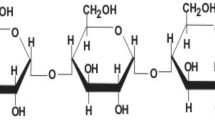Abstract
This paper reports chemoenzymatic synthesis of amylose-grafted polyacetylene according to the following polymer reaction manner. At first, the amine-functionalized polyacetylene was prepared by the Rh-catalyzed copolymerization of a protected amine-substituted acetylene monomer (tert-butyl propargylcarbamate) with N-propargylethanamide, followed by deprotection process. Then, the maltooligosaccharide chains were introduced on the polyacetylene by the reaction with maltoheptaose lactone. Finally, the phosphorylase-catalyzed enzymatic polymerization from the oligosaccharides on the produced polyacetylene was performed using α-d-glucose 1-phosphate as a monomer to give the polyacetylene having amylose graft-chains. Furthermore, the cross-linking reaction of the remaining amino-groups on the amylose-grafted polyacetylene with hexamethylene diisocyanate was carried out in DMSO to give the insoluble material, which formed the organogel with DMSO. The mechanical property of the gel was evaluated by compressive stress–strain measurement.












Similar content being viewed by others
References
Stenger-Smith JD (1998) Intrinsically electrically conducting polymers. Synthesis, characterization, and their applications. Prog Polym Sci 23:57
Yamamoto T, Hayashida N (1998) π-Conjugated polymers bearing electronic and optical functionalities. Preparation, properties, and their applications. React Functional Polym 37:1
Kadokawa J, Shinmen Y, Shoda S (2005) Synthesis of glucose-containing polyaniline by the oxidative polymerization of N-glucosylaniline. Macromol Rapid Commun 26:103
Hasegawa T, Kondoh S, Matsuura K, Kobayashi K (1999) Rigid helical poly(glycosyl phenyl isocyanide)s: synthesis, conformational analysis, and recognition by lectins. Macromolecules 32:6595
Baek M-G, Stevens RC, Charych DH (2000) Design and synthesis of novel glycopolythiophene assemblies for colorimetric detection of influenza virus and E. coli. Bioconjugate Chem 11:777
Yamashita Y, Kaneko Y, Kadokawa J (2007) Synthesis of glucose-substituted poly(p-phenylene)s with twisted main-chain in one direction due to induced axial chirality. Polym Bull 58:635
Yamashita Y, Kaneko Y, Kadokawa J (2007) Synthesis of poly(p-phenylene)s having alternating sugar and alkyl substituents by Suzuki coupling polymerization and evaluation of their main-chain conformations. Eur Polym J 43:3795
Kim I-B, Erdogan B, Wilson JN, Bunz UHF (2004) Sugar-poly(para-phenylene ethynylene) conjugates as sensory materials: efficient quenching by Hg2+ and Pb2+ ions. Chem Eur J 10:6247
Takasu A, Iso K, Dohmae T, Hirabayashi T (2006) Synthesis of sugar-substituted poly(phenylenevinylene)s. Biomacromolecules 7:411
Kadokawa J, Suenaga M, Tawa K, Kaneko Y, Tabata M (2006) Polymerization and copolymerization of a new N-propargylamide monomer having a pendant galactose residue to produce sugar-carrying poly(N-propargylamide)s. J Macromol Sci Pure Appl Chem 43:1179
Suenaga M, Kaneko Y, Kadokawa J, Nishikawa T, Mori H, Tabata M (2006) Amphiphilic poly(N-propargylamide) with galactose and lauryloyl groups: synthesis and properties. Macromol Biosci 6:1009
Ohmae M, Fujikawa S, Ochiai H, Kobayashi S (2006) Enzyme-catalyzed synthesis of natural and unnatural polysaccharides. J Polym Sci Polym Chem 44:5014
Kobayashi S, Ohmae M (2006) Enzymatic polymerization to polysaccharides. Adv Polym Sci 194:159
Ziegast G, Pfannemuller B (1987) Phosphorolytic syntheses with di-, oligo- and multi-functional primers. Carbohydr Res 160:185
Kobayashi K, Kamiya S, Enomoto N (1996) Amylose-carrying styrene macromonomer and its homo- and copolymers: synthesis via enzyme-catalyzed polymerization and complex formation with iodine. Macromolecules 29:8670
Narumi A, Kawasaki K, Kaga H, Satoh T, Sugimoto N, Kakuchi T (2003) Glycoconjugated polymer 6. Synthesis of poly[styrene-block-(styrene-graft-amylose)] via potato phosphorylase-catalyzed polymerization. Polym Bull 49:405
Jonas G, Stadler R (1994) Carbohydrate modified polysiloxanes II. Synthesis via hydrosilation of mono-, di- and oligosaccharide allylglycosides. Acta Polym 45:14
Braunmühl V, Jonas G, Stadler R (1995) Enzymatic grafting of amylose from poly(dimethylsiloxanes). Macromolecules 28:17
Braunmühl V, Stadler R (1998) Synthesis of aldonamide siloxanes by hydrosilylation. Polymer 39:1617
Loos K, Jonas G, Stadler R (2001) Carbohydrate modified polysiloxanes, 3. Solution properties of carbohydrate–polysiloxane conjugates in toluene. Macromol Chem Phys 202:3210
Kamiya S, Kobayashi K (1998) Synthesis and helix formation of saccharide-poly(l-glutamic acid) conjugates. Macromol Chem Phys 199:1589
Matsuda S, Kaneko Y, Kadokawa J (2007) Chemoenzymatic synthesis of amylose-grafted chitosan. Macromol Rapid Commun 28:863
Kaneko Y, Matsuda S, Kadokawa J (2007) Chemoenzymatic syntheses of amylose-grafted chitin and chitosan. Biomacromolecules 8:3959
Kadokawa J, Nakamura Y, Sasaki Y, Kaneko Y, Nishikawa T (2008) Chemoenzymatic synthesis of amylose-grafted polyacetylenes. Polym Bull 60:57
Yanase M, Takata H, Fujii K, Takaha T, Kuriki T (2005) Cumulative effect of amino acid replacements results in enhanced thermostability of potato type L α-glucan phosphorylase. Appl Environ Microbiol 71:5433
Deng J, Tabei J, Shiotsuki M, Sanda F, Masuda T (2004) Conformational transition between random coil and helix of poly(N-propargylamides). Macromolecules 37:1891
Schrock RR, Osborn JA (1970) π-Bonded complexes of the tetraphenylborate ion with Rhodium(I) and Iridium(I). Inorg Chem 9:2339
Acknowledgments
The authors are indebted to Ezaki Glico Co. Ltd, Osaka for the gift of phosphorylase. J. K. acknowledges the financial support from the Asahi Glass Foundation.
Author information
Authors and Affiliations
Corresponding author
Rights and permissions
About this article
Cite this article
Sasaki, Y., Kaneko, Y. & Kadokawa, Ji. Chemoenzymatic synthesis of amylose-grafted polyacetylene by polymer reaction manner and its conversion into organogel with DMSO by cross-linking. Polym. Bull. 62, 291–303 (2009). https://doi.org/10.1007/s00289-008-0025-8
Received:
Revised:
Accepted:
Published:
Issue Date:
DOI: https://doi.org/10.1007/s00289-008-0025-8




